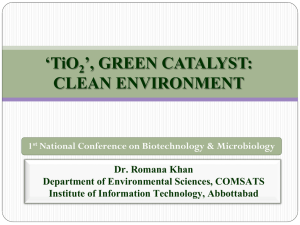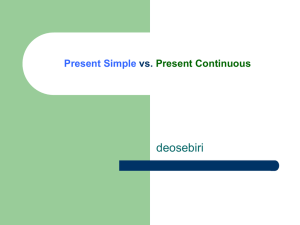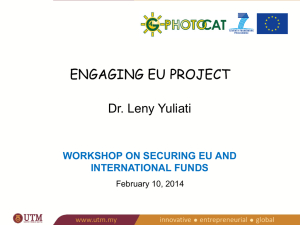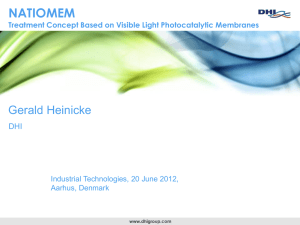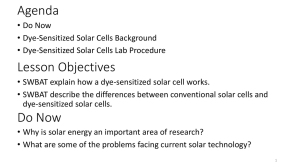Fotocatálise - PhotoCatalysis.info
advertisement
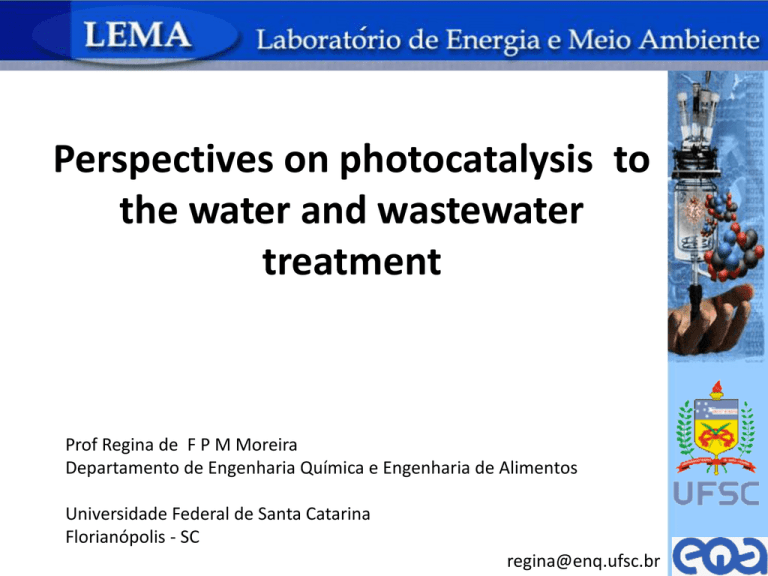
Perspectives on photocatalysis to the water and wastewater treatment Prof Regina de F P M Moreira Departamento de Engenharia Química e Engenharia de Alimentos Universidade Federal de Santa Catarina Florianópolis - SC regina@enq.ufsc.br Photocatalysis Number of papers in Photocatalysis: 1975–1980: 249 2000–2010: 16.757 2500 photocatalyst 2000 photocatalysis 1500 TiO2 - the most used photocatalyst (non-toxic, stable and not expensive) Air treatment Water and wastewater treatment 1000 500 Self cleaning surfaces 2012 2011 2010 2009 2008 2007 2006 2005 2004 2003 2002 0 Number of papers/year (www.sciencedirect.com) Number of patents in photocatalysis Publications about “nanoparticle photocatalysts” Balkus Jr, K., New and Future Developments in Catalysis Catalysis by Nanoparticles, 2013, Pages 213–244 Photocatalysis (1975–1985) semiconductor/solution interface under UV irradiation several semiconductors Polycristalline materials were the most suitable. Photocatalysts in aqueous suspensions. (1986 - 2000) Thin films; Doping of semiconductors to explore visible light; Dye sensitization (photocatalysts in aqueous suspension). Industrial activities. (2006–2010): Nanophotocatalysts Photocatalysts •Semiconductors •Conduction Band (CB) electrons have a chemical potential of + 0.5 to -1.5 V vs NHE hence they can act as reductants. •Valence Band (VB) holes exhibit a strong oxidative potential + 1.0 to + 3.5 V vs NHE Photocatalytic activity and semiconductor properties Energy band configuration determinates the absorption of incident photons, photoexcitation of electron-hole pairs, migration of carriers, and redox capabilities of excited-state electrons and holes. Band-edge positions of semiconductor photocatalysts relative to the energy levels of various redox couples in water. Energy bands engineering H Tong, S Ouyang, Y Bi, N Umezawa, M Oshikiri, J Ye, Nanophotocatalytic materials: possibilities and challenges, Adv Mater 2012, 24, 229-251. Photocatalysts ENERGY BAND ENGINEERING Some important aspects: - Optical absorption: direct and narrow bandgap semiconductors are more likely to exhibit high absorbance suitable for the efficient harvesting of low energy photons. - Disadvantages: - recombination electron/hole - Band-edge positions are frequently incompatible with the electrochemical potential necessary to trigger specific redox reactions - Modulate the band gap and band-edge positions in a precise manner different strategies - Improvement of light sensitization by the inclusion of quantum dots, plasmon-exciton coupling between anchored noble metal nanoparticle cocatalysts and the host semiconductor, and photon coupling in semiconductor photonic crystals. Energy Band Engineering I. Modiulation of VB II. Adjustment of the CB III. Continuous modulation of the VB and/or CB Photocatalytic degradation of pollutants in water or wastewater oxygen as electron acceptor • VB Redox potential should be sufficiently positive in order to the holes act as electron acceptor ; oxidation reaction • CB: Redox potential should be sufficiently negative in order to the oxygen act as electron acceptor reduction reaction A. Millis and S. L. Hunte J. Photochem. Photobiol. A: Chem 180 (1997) 1 Energy Band Engineering Oxide semiconductors CB slightly negative ; VB significantly positive with respect to the oxidization of H2O (vs NHE). Therefore For the consideration of stability of materials, raising to top of the VB to narrow the bandgap takes precedence over all other methods of energy-band modulation. To adjust the level of the VB: the most effective strategies: I. Doping with 3d transition elements II. Cations with d10 our d10s2 configurations III. Non-metal elements Energy band engineering • A) TiO2 Doping N, S, C, metals strategies to raise the VB maximum • B) TiO2 Dye surface sensitization • C) Surface modification to increase stability • D) Coupled semiconductors • E) Novel semiconductor containing 3d metals. Miao Zhang et al, Angew. Chem. Int. Ed. 2008, 47, 9730 –9733 A) Doping with non-metal: C, N, P, B, S A.1.1 Doping with sulfur A.1.2 Doping with nitrogen Successful example of band-edge control for the utilization of visible light mechanism under debate. - Hybridization of the N-related states with the host VB; - N-doping in TiO2 is accompanied by formatin of Ti3+ via donor-type deffects Mechanism of photocatalytic activity of TiO2 doped with S S.X. Liu, X.Y. Chen, J. Hazard. Mater. 152, 48–55 (2008) K. HASHIMOTO et al. Jpn. J. Appl. Phys., Vol. 44, No. 12 (2005) • Doping with N, C, S narrows the bandgap by less than 0.3 V. • Significant extension of visible light absorption via anion doping remains a big challenge. Photocatalytic degradation of Phenol in aqueous solution using nanowires of Ndoping TiO2 Ilha, José, Moreira, Degradação fotocatalítica de fenol utilizando nanofios de dióxido de titânio modificados com nitrogênio). UFSC, 2012 Nanofio dopado Nanofio com nitrogênio Photocatalyst Bandgap (eV) TiO2 P25 3,05 Nanowire TiO2 2,62 N-doped TiO2 nanowired 2,53 Pseudo first order kinetic constant for the phenol minearlization using different photocatalysts Catalisador k' (10-3min-1) P25 2,6 nanowireTiO2 0,6 N doped TiO2 nanowired 1,1 Phenol initial concentration: 100 mg/ L; Photocatalyst dosage 1g/L. N doped TiO2 Effect of nitrogen content Theoretical studies: only 1% atomic% N (0.53 % w/w) on TiO2 is necessary to activate photocatalytic reactions under visible light. Fu, Zhang, Zhang, Zu, J Phys Chem B 2006, 110, 3061. Decomposition of rhodamine B after 1 h using TiO2 or N- TiO2 (different N/Ti ratio) under visible light. Ye Cong et al., J. Phys. Chem. C, Vol. 111, No. 19, 2007, 6976-6982 B – Metal doping CB e-(M) M+e-e- e- e- e- e- e- e- e- e- e- e- eEg Recombination e-/h+ VB h+ h+ h+ h+ h+ h+ h+ h + h+ h+ Metal promoter: attracts the electrons to the CB recombination is inhibited. B – Metal Doping • ionic radius of the metal similar to the Ti4+ , • Exhibit 2 or more oxidation states. • Energy levels Mn+ /M(n+1) similar to Ti3+ /Ti4+ , • Electronegativity: higher than Ti • incomplete/parcial electronic configuration Ionic radius B – Noble metals doping Fotoactivity of TiO2 doped with Pt effect of the metal concentration on the production of methane by the photoreaction: CO2 + H2O CH4 + O2 Effect of Pt-metal content in Pt/TiO2 (P25) catalysts on CH4 yield for photocatalytic reduction of CO2 after 7 h UV irradiation at 323 K, H2O/CO2 = 0.02. Q.-H. Zhang et al. / Catalysis Today 148 (2009) 335–340 B – Non noble metal doping Capítulo 6 Copper, zinc and Chromium De Bem Luiz et al., Journal of Photochemistry and Photobiology A: Chemistry 246 (2012) 36– 44 • Photocatalyst synthesis: photodeposition by controllingl of precursor metals solubility Capítulo 6 B - Non-noble metals doping Copper, zinc and Chromium De Bem Luiz et al., Journal of Photochemistry and Photobiology A: Chemistry 246 (2012) 36– 44 • Photocatalytic denitrification: – Photoreduction of NO3- to produce N2 – Hole scavanger: Formic acid (electron donor) – Nitrate electron acceptor • Theoretical molar ratio to reduce nitrate to nitrogen CHOOH:NO3- = 8:1 𝑁𝑂3− + 2𝑒 − + 𝐻2 𝑂 → 𝑁𝑂2− + 2𝑂𝐻− 𝑁𝑂2− + 6𝑒 − + 7H + → 𝑁𝐻3 + 2𝐻2 𝑂 2𝑁𝐻3 → 𝑁2 + 3𝐻2 2𝐻𝐶𝑂𝑂 − + ℎ+ → 𝐶𝑂2 + 𝐶𝑂2°− + 𝐻2 De Bem Luiz et al., Journal of Photochemistry and Photobiology A: Chemistry 246 (2012) 36– 44 B – Non-noble metal doped TiO2 NH4+ main byproduct No N-byproducts Time, min Kinetics of photocatalytic degradation of nitrate and formic acid (measured as TOC), and formation of products (ammonia and nitrite) pH 2.5. TiO2, Zn-TiO2, Cr-TiO2 e Cu-TiO2 = 1g L-1. NO3- = 0.6 mM (9 mg N L-1); CHOOH = 9.8 mM (117.4 mg COT L-1). Moreira., Journal of Photochemistry and Photobiology A: Chemistry 246 (2012) 36– 44 B – Non noble metal doping Capítulo 6 • Copper, zinc or chromium: – Zn-TiO2: higher photocatalytic activity than Cr-TiO2 or Cu-TiO2, and lower byproducts formation. – Zn action To promote efficient charge separation (e-/h+) Moreira et al., Journal of Photochemistry and Photobiology A: Chemistry 246 (2012) 36– 44 B – Doping with non noble metals • Effect of dissolved oxygen on the photocatalytic activity of Zn-TiO2 – O2 competes with NO3- ions, acting as electron acceptor Photocatalytic nitrate reduction using 4.4% Zn–TiO2 as photocatalyst Presence of O2 (air) By purging argon (without O2 Selectivity [%] Nitrate conversion after Activity [µmolNO3- (min gcatalisador) -1] 2 h[%] 77.2 87.5 4.11 95.4 91.7 14.24 Moreira et al., Journal of Photochemistry and Photobiology A: Chemistry 246 (2012) 36– 44 C) Coupling semiconductors Ensemble of nanoparticles may exhibit new collective properties resulting from the inter-particle coupling of surface electrons (excitons), plasmons or magnetic moments. Illustration of an electronic bond formed between (A) two atoms and (B) two nanocrystals. - induce a substantial alteration of the electronic structures of the nanoparticle ensemble bonding and anti-bonding levels are formed, yielding a new electronic structure. Tong, Ouyang, Bi, Umezawa, Oshikiri, Ye, Adv Mater 2012, 24, 229. C) Coupling semiconductors Interesting way to increase the efficiency of a photocatalytic process: - by increasing the charge separation - by extending the energy range of photoexcitation for the system - by extending The potential of VB or CB of coupled semiconductors should be more negative or less positive, respectively, than pure TiO2 Hole produced in the VB remains in the CdS particle Electron it is transferred to the CB of TiO2 particle. The electron transference from CdS to TiO2 increase the charge separation and the photocatalytic efficiency. Sclafani, A.; Mozzanega, M.-N.; Pichat, P. J. Photochem. Photobiol. A: Chem. 1991, 59, 81. Hybrid seminconductors– TiO2/graphene is promising to simultaneously possess excellent adsorptivity, transparency, conductivity, and controllability, which could facilitate effective photodegradation of pollutants. Graphene increase the electric conductivity, charge transfer and chemical stability - Decrease recombination electron/hole due to the high electronic conductivity of graphene; - High active site concentration, due to the high ratio area:volume, and bidimensional structure - High range of light absorption -TiO2/graphene composites Strong interaction aromatic rings of graphene and organic molecules Bond Ti-O-C graphene acts as co-catalyst (Lv et al., Procedia Engineering 27 (2012) 570-576. TiO2 (P25)-graphene photocatalytic activity is higher than pure TiO2 P25 (Zhang et al., 4 (2010) 380) TiO2/Graphene Scheme of the Photocatalytic Degradation of methylene blue (a) TiO2 (b) TiO2/Graphene E. Lee et al. / Journal of Hazardous Materials 219– 220 (2012) 13– 18 High activity results from: Kinetic of photocatalytic degradation of Rhodamine B Kinetic constant for the photocatalytic degradation of Rhodamine B • Strong coupling between TiO2 on graphene oxide facilitate interfacial change transfer; • (GO ) acts as electron acceptor and inhibits the e/h recombation. Liang et al, Nano Res,2010. Huimin et al., Chinese Journal of Catalysis, 33 (2012) 777-782. ZnFe2O4/Magnetic graphene Spinel ZnFe2O4 (Eg= 1.90 eV) Magnetic semiconductor material Nanosheets of graphene and ZnFe2O4 nanocrystals Comparing ZnFe2O4 and ZnFe2O4/grafeno • Composite ZnFe2O4/grafeno catalyst for photodegradation • Generation of HO* radicals via photochemical reactions of H2O2 under visible light ZnFe2O4 – with (a) and without (b) magnetic field The photogenerated electrons of excited ZnFe2O4 were transferred instanteously from the conduction band of ZnFe2O4 to graphene at the site of generation via a percolation mechanism, resulting in a minimized charge recombination enhanced photocatalytic activity Fu e Wang, Ind Eng Chem Res 50 (2011) 7210-7218. Lanthanide modified semiconductor photocatalystss The biggest difference between the transition metal ion and the lanthanide ions nature of the 4f orbitals Lanthanide excellent optical properties • Incorporation of Rare-Earths metal ions leads to the formation of multi energy levels below the conduction band edge of TiO2 • Lanthanide ions may act as electron scavenger and suppress e/h recombination; Photocatalytic activity of Ln3+/TiO2 Weber, Grady and Kookdali, Cat Sci & Tech 2012, 2, 683. • Lanthanite ions also can faciliate the adsorption of organics or act as electron acceptors (minimizing e/h recombination) General enhancement in the photocatalytic activity: - Enhanced adsorption of the organics; - Effective separation of e/h - High intrinsic absorptivity under UV irradiation due to the ability of RE metal ions to trap electrons and minimize e/h recombination CeO2/TiO2 TOC removal efficiencies (Methylene blue) during visible light irradiation (t=180 min) (a) UV vis absorption spectra fo undoped and Ce-doped TiO2 microspheres (b) Photographs of Ce-doped TiO2 samples Effect of cerium doping the photocatalytic activity to degrade methylene blue: From 1 – 5% cerium excess Ce4+ dopants may introduce the indirect recombination of electrons and holes to reduce the photocatalytic activity. J. Xie et al. / Colloids and Surfaces A: Physicochem. Eng. Aspects 372 (2010) 107–114 CeO2/TiO2 Photocatalytic degradation of methylene blue – different catalysts and P25 Photocatalytic degradation of Rhodamine B– different catalysts and P25 J. Xie et al. / Colloids and Surfaces A: Physicochem. Eng. Aspects 372 (2010) 107–114 Compósitos de TiO2 dopados com Er3+:YAlO3/Fe- e Co •Fe and Co ions doped into TiO2 powder to restrain the recombination •Er3+:YAlO3 upconversion luminescence agent can transform the visible light into UV light more efficiently Degradation of organic compounds in the presence of Er3+:YAlO3/(Co or Fe)/TiO2 under visible light • Visible light is converted luz UV pelo Er3+:YAlO3. • UV light can excite TiO2 -> electrons transfer from VB to CB •e/h pairs no recombination due to presence of Fe or Co ions R. Xu et al. / Solar Energy Materials & Solar Cells 94 (2010) 1157–1165 TiO2 composites doped with Er3+:YAlO3/Fe- or Co 25% Er3+YAlO3/Fe/TiO2 25% Er3+YAlO3/Co/TiO2 10% Er3+YAlO3/Co/TiO2 5% Er3+YAlO3/Fe/TiO2 Fe/TiO2 Co/TiO2 Photocatalytic degradation of azo fuchsine int the presence of photocatalysts Fe or Co/TiO2 and different amouns of Er3+:YAlO3 R. Xu et al. / Solar Energy Materials & Solar Cells 94 (2010) 1157–1165 Bismutum Spinels BiWO6, Bi4Ti3O12, BIOX (X=Cl, Br, I), Bi2O3 photocatalytic activity under UV and visible light Eg = 2,9 a 3,5 eV, depending on the preparation method (Chen et al., 2012). Bi2S3 Eg= 1,3 a 1,7 eV (Mesquita e Silva, 34ª Reunião SBQ, 2011). * Bi2O2CO3 High activity: morphology, low band gap energy. (Chen et al., 2012) * CdBiYO4 (Du and Juan, Solid State Sciences, 14 (2012) 1295-1305) spinel Copper nanowires CuO Eg ~1.2 eV Nanowires CuO e Cu(OH)2 FESEM images of sample Nanowires of CuO Efficient charge separation and increase of photocatalytic activity UV absorption spectra of CuO nanowires Photocatalytic degradation of Rhodamine B using different photocatalysts under UV light Yu Li, Xiao-Yu Yang, Joanna Rooke, Guastaaf Van Tendeloo, Bao-Lian Su. Ultralong Cu(OH)2 and CuO nanowire bundles: PEG200-directed crystal growth for enhanced photocatalytic performance, Journal of Colloid and Interface Science 348 (2010) 303–312 Tungstenium oxides WO3 + co-catalyst(Pt, Cu, or Pd): high photocatocalytic efficency to degrade organics WO3 --> Conduction Band ( +0.5 V vs NHE) is more positive than that for O2 reduction O2 + e = O2*- (aq) 0.284 V vs NHE; O2 + H+ + e = HO2* (aq), 0.046 V vs NHE WO3 can act as photocatalyst sensible to visible light in the presence of an electron acceptor (ozônio +2.07 V vs NHE). Ozone reacts with the photoexcited electrons oxidation of organic compounds WO3 Eg = 2,5 ev S. Nishimoto et al. / Chemical Physics Letters 500 (2010) 86–89 Photocatalytic degradation of Phenol TOC initial = 130 ppm S. Nishimoto et al. / Chemical Physics Letters 500 (2010) 86–89 Photocatalytic degradation of Phenol TOC initial = 130 ppm E) Photocatalysts d0 e d10 Óxidos metálicos Domen et al. New Non-Oxide Photocatalysts Designed for Overall Water Splitting under Visible Light. J. Phys. Chem. 2007 d0 Ti4+: TiO2, SrTiO3, K2La2Ti3O10 Zr4+: ZrO2 Nb5+: K4Nb6O17, Sr2Nb2O7 Ta5+: ATaO3(A=Li, Na, K), BaTa2O6 W6+: AMWO6 (A=Rb, Cs; M=Nb, Ta) d10 Ga3+: ZnGa2O4 In3+: AInO2 (A=Li, Na) Ge4+: Zn2GeO4 Sn4+: Sr2SnO4 Sb5+: NaSbO7 Generally, the band gap energy is high Photocatalytic activity of oxides and nitrides d10 metals it is associated with the CB of the hybridized sp-orbitals, that are able to produce photoexcited eletrons with high mobility. Final Remarks The function and engineering of co-catalysts is one of the most important subjects in photocatalysis. Challenge and perspectives photocatalysts sensible to visible light and high activity Promissor materials Graphene Rare earths Composites and doped co-catalyts Reactor design is still a big challenge Thank you regina@enq.ufsc.br
